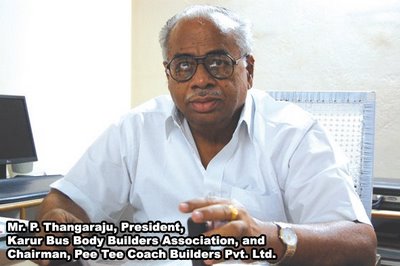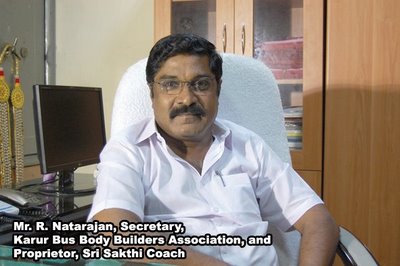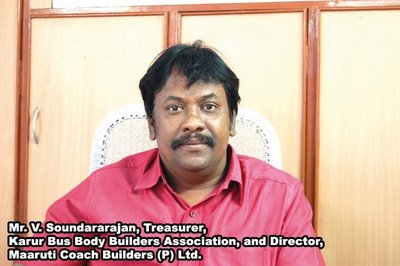Cluster formation, a shot in the arm for bus body builders
 The implementation of the Code of Practice for bus body building is round the corner, and many fear that this will put an end to business of small bus body builders in the country. In fact, I should confess that even I was of the opinion that the introduction of the Bus Code will sound the death knell for smaller bus body building units. Karur was one destination which everyone had their eyes on. It is a small town in the hinterland of Tamil Nadu with a concentration of 50+ bus body builders with a capacity to manufacture 5 to 50 buses a month totalling 4,000 buses in a year.
The implementation of the Code of Practice for bus body building is round the corner, and many fear that this will put an end to business of small bus body builders in the country. In fact, I should confess that even I was of the opinion that the introduction of the Bus Code will sound the death knell for smaller bus body building units. Karur was one destination which everyone had their eyes on. It is a small town in the hinterland of Tamil Nadu with a concentration of 50+ bus body builders with a capacity to manufacture 5 to 50 buses a month totalling 4,000 buses in a year.
But if is there is anyone out there writing off the Karur Bus Body builders, here is some interesting news and probably some learning as well. To combat the challenge ahead, the bus body building units at Karur have come together and formed what is called, Karur Bus Body Builder Cluster Ltd., an independent entity, which will act as a common facility centre for the various units in Karur.
To know more about this cluster, I recently met Mr. P. Thangaraju, President of the Karur Bus Body Builders Association, and Chairman and Managing Director of PeeTee Coaches, one of the leading bus body building units in Karur. “We have come together to take on the challenge ahead”, says a confident Mr. Thangaraju.
There are a couple of things that readily impress me. First, the very fact that the body builders at Karur have taken the bus code very seriously and have taken the first step in working towards this. Secondly, there is a genuine interest taken by the senior members of the Association to come together for the benefit of all the bus body builders in the town.
According to a report prepared by Group Synergy Project Consultants to the Karur Bus Body Builders’ Association, currently there are about five lakh buses on Indian roads with an average age of 4 to 5 years. The total number of buses sold in the last three years alone is 1,30,000 units, including over 50,000 buses sold in 2007-08 alone. The number of fully-built buses sold by the manufacturers directly and by the organized sector is less than 20,000 every year. The rest of the buses are built by the unorganized sector. The unorganized bus body builders are spread across the country with concentration in Tamil Nadu, Andhra Pradesh, Delhi, Chandigarh, Jalandhar, Rajasthan and West Bengal. If you go through the history of the bus body building industry in Karur, you will find that it all started with one company called L G Balakrishna & Bros. This was the first company to have started building buses decades ago. It was in the 1980s that some of the employees of LGB came out and started their own units, and slowly the units started multiplying in numbers and today there are more than 50 units, building over 4,000 buses with a total turnover of Rs. 400 crores.
If you go through the history of the bus body building industry in Karur, you will find that it all started with one company called L G Balakrishna & Bros. This was the first company to have started building buses decades ago. It was in the 1980s that some of the employees of LGB came out and started their own units, and slowly the units started multiplying in numbers and today there are more than 50 units, building over 4,000 buses with a total turnover of Rs. 400 crores. The sad part of the story is that LGB, the parent company, has today moved out of this business. But there is definitely a sense of gratitude among the bus body building community who unhesitatingly dedicate their success to the strong foundation laid by LGB.
The sad part of the story is that LGB, the parent company, has today moved out of this business. But there is definitely a sense of gratitude among the bus body building community who unhesitatingly dedicate their success to the strong foundation laid by LGB.
Karur has been traditionally building stage carriers catering to the requirement of private operators and government transport undertakings in the southern States. Of late, some of the Karur units have executed some significant orders for MTC in Chennai for semi-low floor buses. Many units are also catering to the requirements of staff transportation services provided by operators like Parveen and SRS. Very few companies have focused on exports. PeeTee Coaches is one company which has managed to focus on exports by setting up a dedicated unit.
Although some of the bus body builders have the experience of building luxury buses and even a few AC buses, the expertise is more in standard semi-luxury buses or ‘mofussil’ buses, as it is locally known. They have confined themselves to a segment which has growing requirement and created enough capacity to cater to that requirement.
In fact, the State transport corporations in the four southern states have a fleet size of close to 80,000 buses. Even to cater to their annual replacement demand will require huge capacities to be created.
Cluster formation
Coming to the topic of cluster formation, Mr. Thangaraju says that it all started three years back when the Government identified Karur bus body building as an important industry to be developed under the SME sector. A detailed study was made and report submitted on the ways to take this industry forward. The Association of Coach Builders, State Government and Central Government made a detailed study, resulting in the emergence of Karur Bus Body Cluster Private Ltd.
Thanks to the proactive schemes of the Union Government, Ministry of Micro, the Small and Medium Enterprises called MSME the local arm the MSME development Institute at Guindy, Chennai, actively co-operated with the Karur cluster to put together a relevant grant package under the MSECDP scheme that has catalyzed a feverish activity at Karur to rediscover their strengths and reorganize to take the future head-on.
The Cluster envisages creating a Common Facility Center (CFC) with a capital outlay of Rs. 9.5 crores out of which 70 per cent will be funded by the Central Government, 15 per cent by the State Government and the balance 15 per cent will be contributed by the bus body builders who will become members of the cluster. The cluster will require a minimum of 20 members to start with and this has been signed up, says Mr. Thangaraju.
What does the cluster do? The introduction of the Bus code is to ensure that all buses comply with certain specification that cover, Passenger Safety, which is an important factor. In fact studies on road accidents indicate that, there is a high incidence of road accidents in India and many of them involving buses. It has also been identified in many cases that the poor design of buses may have been responsible for loss of life, which could have been avoided had they followed some safety norms.
Hence CIRT and ARAI have come out with standards for bus body building taking into account all the safety aspects. In fact, prior to the implementation of the bus code, it has been stipulated that all the bus body building units in the country will have to go through the process of accreditation by the CIRT to comply with minimum requirements in terms of infrastructure and machineries for bus manufacturing. In fact, the accreditation process has already started and many units in Karur have gone through the inspection and audits.
But the fact remains that, to comply with the mandatory requirements, it will require significant investments in new machineries, infrastructure and desi
gn capabilities by individual units. This makes it difficult for smaller bus body building units to make such huge investments in improving infrastructure. Also as per the rules, once the Bus Code is implemented, every new bus model being developed by bus body builders will have to be approved and certified by the ARAI before it hits the road.
Individual units will have to obtain approval for the body structure from ARAI and CIRT and also comply with crash tests and roll over tests. Body building units will have to set up phosphating plants for preventing rusting of the structures. The bus code also specifies safety features like door-width, seat-pitch, aisle-space and rear-view mirrors.
With the establishment of the Cluster, a Common Facility Centre (CFC), wherein the entire infrastructure necessary for manufacturing the various components required as per the regulations, will be created. It will have CNC bending, cutting, shearing machines, phosphating plant, paint booths and complete design capabilities. All member-units can get the components manufactured out of the CFC in a kit-form and then assembled these bus-kits on chassis at their own facility prior to final testing and delivery.
The plan is to establish the CFC equipped with advanced testing facilities, design centre & quality testing laboratories to help the coach builders in their quest for achieving international standards. The advantages are many. There is no requirement for individual bus units to invest as there is the CFC. The buses body builders will become more as assembling units, which ensures faster manufacturing and delivery to customers. It now takes 20 days to build a bus at Karur. With the CFC in place it will take just a week or 10 days to build the bus. Therefore the CFC simply means higher productivity, increased capacity, reduced cost of manufacture and long-term business visibility for the currently stuttering units.
Some estimate that the capacity can be doubled from the existing 4,000 to 8,000 units with the setting up of the CFC. Also faster deliveries means that the customer can put the vehicle on road and start earning revenues.
The CFC will also work on some standard bus design models which have been approved by ARAI, and these models can be built at the various units, it could be for city, mofussil or luxury buses for long distance.
Another important activity of the cluster is to create a common sourcing platform for all its members whereby, the raw material required for bus body like steel, aluminium, seats, rubber components, sealants, to name a few, will be bought in bulk. This will give them a definite price advantage as they will buy in bulk and transfer the benefit to its members. They can start directly negotiating with the manufacturers which will ensure better rates and consistent quality.
The bus body building industry is witnessing rapid growth in India both in terms of technology and business volumes. At the same time it is governed by an urgent need for increased passenger safety and value for money. Predictably, many global players, including Volvo, Mercedes, Marcopolo and Irizar, have launched their buses in India powered by their technology might, setting benchmarks of quality, safety and comfort. Tata Marcopolo, for example, is setting up a facility in Dharwad for 3,000 buses annually. This will have a definite impact on several of the indigenous and small units, including those at the Karur cluster who face an imminent threat of being elbowed out.